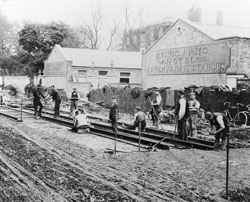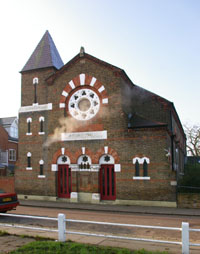Fred Pearce
Twickenham Borough Surveyor and stalwart of the Congregational Church
1866 - 1928

The development of Twickenham in the early 20th century
Twickenham at that time was little more than a village, with a population of 1600, but was fast developing into a town. Pearce personally supervised the laying out of some 70 new roads in 10 years, the District Council of those days having decided to undertake the development of roads on a more systematic basis. Pearce was responsible for widening many roads in the borough - Richmond Road was widened as we know it today and he extended the trams to Hampton Court. Under Pearce, Radnor House grounds were raised to prevent flooding (making today's Radnor Gardens), conveniently using material recovered from the construction of Teddington Lock and saving the town many hundreds of pounds.

Pearce modernised the Fire Brigade, replacing the horse-drawn engines and enlarging the station. He constructed a sewage works, an isolation hospital in Whitton (1906) and built new schools. Being a keen educationalist, he knew exactly what were the requirements of an elementary school. The Orleans Schools (1910) and the Nelson Schools were all constructed under his aegis.

Wartime Activities
With the coming of the First World War, he took on the additional roles of fuel officer and transport officer for the Council. During this period, he improved the riverside path between Marble Hill, preserving, as far as possible, the trees beside the river and the view from Richmond Hill. When York House was purchased by the Council in 1924, he supervised the necessary alterations and the transfer of offices from the old Town Hall, all at a time when Pearce and his department were working at their hardest. The purchase of the Orleans Riverside Land, the development of Cambridge Gardens and of the Cross Deep Estate, and the widening of King Street, St. Margaret's Road, Strawberry Vale, and Cross Deep were all completed at this time, together the extensive development of council housing.
He was once described as Twickenham Council's greatest public asset and he would reply to anyone who questioned what he said with "yes I did say so, and meant what I said. I am sorry I cannot make myself plainer, but the facts are as I have stated and I have nothing to withdraw or add".

Deacon and Secretary of the Congregational Church
He was a devoted member of the Congregational Church (now the United Reformed Church) on Twickenham Green, becoming deacon for 18 years and was church secretary, never losing sight of the place the church fills in the spiritual life of its people. He was active in local organisations, being a member both of the Richmond Lodge and Richmond Chapter of the Freemasons, the Twickenham Rotary Club, the Lower Thames Valley Association of Surveyors, the Institute of Municipal and County Engineers, vice-president of the Twickenham Rifle Club and of the Twickenham Philanthropic Society.
He died on the morning of Sunday 14th April 1928, at his house in Spencer Road, Strawberry Hill. The news reached the Congregational Church just as the pastor was about to ascend to the pulpit - the service was abandoned. His funeral was held at the Church the following Thursday and was attended by the Mayor and Corporation.




